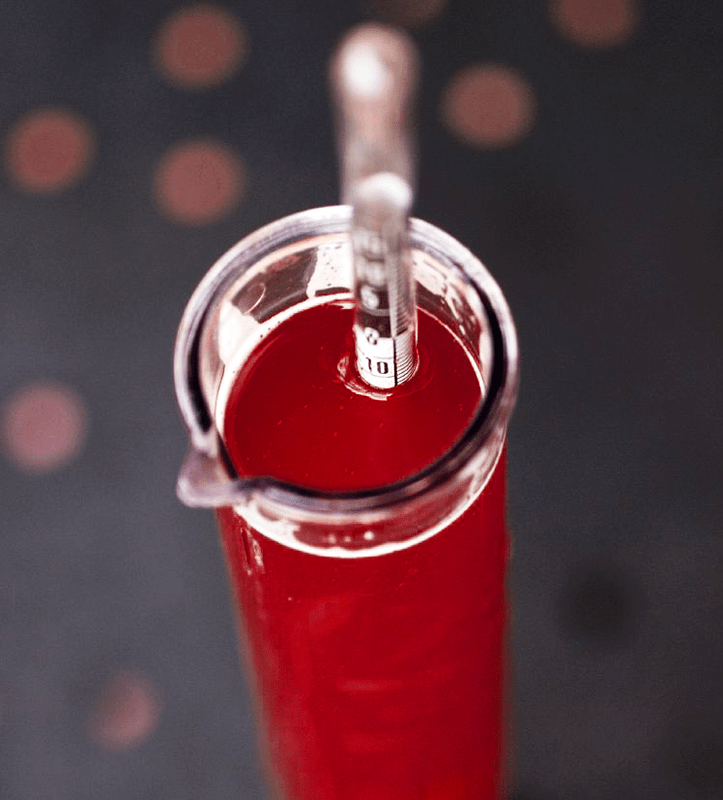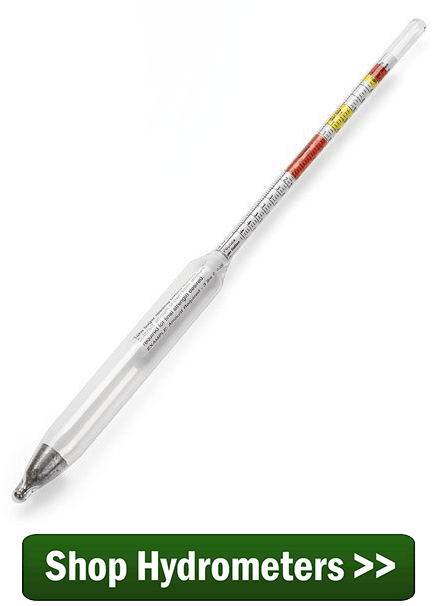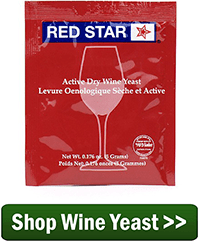 How do I get more potential alcohol alcohol on my wine hydrometer. I want to get the level up to 10 or 11% when making a dry wine without adding sugar?
How do I get more potential alcohol alcohol on my wine hydrometer. I want to get the level up to 10 or 11% when making a dry wine without adding sugar?
Name: Jay K.
State: Arkansas
—–
Hello Jay,
Thanks for the great questions about how to get more potential alcohol. This question covers some areas of confusion for many home winemakers. Let’s see if we can clear it up a little.
Let me start off by making something clear. The only way to raise the potential alcohol reading of a wine is to add more sugar to it. The potential alcohol scale on your wine hydrometer is directly related to the concentration of sugar within it. Add more sugar to the wine must, the potential alcohol reading goes up. The potential alcohol reading on your wine hydrometer comes from sugar, nothing else, so you add more sugar to get more potential alcohol.
The reason for this is very simple. When a wine is fermenting what’s happening? The wine yeast are consuming the sugars and converting them into both CO2 gas (carbon dioxide) and alcohol. Almost exactly half the sugar  turn into CO2 the other half turns in alcohol. The more sugar that is available to the wine yeast the more alcohol you will end up with. So if you put add 2 pounds of sugar and the wine yeast ferment it, you will have added 1 pound of alcohol to the wine.
turn into CO2 the other half turns in alcohol. The more sugar that is available to the wine yeast the more alcohol you will end up with. So if you put add 2 pounds of sugar and the wine yeast ferment it, you will have added 1 pound of alcohol to the wine.
The above is true until the wine yeast have reached their limits of alcohol tolerance. Wine yeast can only ferment so much alcohol. Once the fermentation reaches a high enough level of alcohol, the wine yeast will have difficulty fermenting any further. What this levels “is” depends on several factors: including the strain of wine yeast and the environmental conditions of the fermentation such as temperature, nutrients, etc.
The sugar we are talking about to get more potential alcohol does not have to be cane sugar. It doesn’t even have to be a granulated or powdered sugar. It could come in the form of grape concentrate, honey, apple juice… the list is endless. The sugars from all these things will also raise the potential alcohol level on your wine hydrometer when added to a wine must. Just remember potential alcohol comes from sugar.
So to sum up what you should do to get more potential alcohol:
- Pick out some form of sugar (nothing wrong with using cane sugar);
- Dissolve the sugar into the wine must until the potential alcohol scale on your wine hydrometer reads a reasonable level. (11% to 13% will work fine);
- Let it ferment with an actual domesticated wine yeast.
Happy Winemaking,
Ed Kraus
—–
Ed Kraus is a 3rd generation home brewer/winemaker and has been an owner of E. C. Kraus since 1999. He has been helping individuals make better wine and beer for over 25 years.

Chuck, how much you add is not extremely critical, but normally you would follow a recipe to tell you how much. With out a recipe, I would suggest you add 1/4 teaspoon to each gallon. This is typically added at the beginning of fermentation. If your fermentation has already started it is still okay to go ahead and add it. If the fermentation and your cider has already clear, I would not added it at that point, but simply forgo using it on this batch.
When do you add Tannin to an apple cider batch? How much do you add? What test is used to verify what you are adding? Thanks.
The sweeter the fruit is (higher brix) will require less added sugar to reach same alcohol content as a less sweet fruit. IE Fully ripe & sweet grapes would require less sugar than not fully ripe grapes.
I often find that my wines reach Hydrometer Alcohol Potential + 2% when allowed to ferment to 0.986 SG and double check with a Vinometer prior to any potential post-ferment back-sweetening. IE My potential 16% turns out at 18% to 19%.
Hey Ed!
Read your letter to Jay K. On raising alcohol levels! I like a 13 to 12.5 wine! I have done so for years! I just came back from the Napa Valley, most of there wines are 15%! What yeast do they use to get that high? Or have I never pushed my yeast to go that high? I learned that yeast will die from to much alcohol! What is to much?
Kevin, most wine yeast will produce somewhere between 10-13 percent alcohol with no problem. If you want to try for 15 percent alcohol, our recommendation is to add the additional sugar later, say after the primary fermentation. The Lalvin EC 1118 has a high alcohol tolerance. For more tips and information about making higher alcohol wines, please take a look at the article posted below.
Making High Alcohol Wine
https://eckraus.com/wine-making-high-alcohol/
Your choice of wine yeast will also affect the potential alcohol. Yeast varies in the alcohol tolerance.
My alcohol levels are around 17 % – 19% and I have to add grape juice to make it drinkable. I can drink it plain but a small glass goes right to my head and also leaves a burning sensation on my tongue. I use the Lalvin EC 1118 for yeast and follow recipes except for the sugar which I always add extra. Love the information that you provide. Thank you.
I’m always amazed at people who want to get the highest alcohol possible in their wine. In my opinion, most wine should be no higher than about 13.5-14% alcohol. Otherwise the wine would be out of balance or “hot”. If you’re looking only for a buzz, get a bottle of alcohol.
I would like to learn about yeast nutrient, if you should use it and when, also the amount.
Vin Vento, The following article will explain in detail the importance of yeast nutrients.
Yeast Nutrients
https://blog.eckraus.com/what-are-yeast-nutrients-in-wine-making
Ed,
Thanks for all you do
What would be the consequence or consequences of reducing the volume of the grape concentrate I get in a VineCo kit?
Could I expect a more grapey flavor in the wine?
Jack, Because the manufacturer has formulated these kits to have the correct balance, we do not recommend altering the directions for the kits. The balance will be thrown off if you eliminate some of the water. For example, this would leave the acid level too high and a would result in a sour tart wine.